Behold the avian marvels adorned with nature’s edgy elegance, 23 Stunning Birds With Mohawks. From vibrant hues to intricate crests, these feathered trendsetters redefine avian fashion.
This compilation unveils a feathered brigade, each species flaunting its unique mohawk-inspired plumage.
Delve into the fascinating world of avian haute couture as we explore the striking Eurasian Hoopoe, the charismatic Sulphur-crested Cockatoo, and many other winged wonders.
Beyond mere aesthetic appeal, these mohawked birds offer insights into evolutionary adaptations, behavioral peculiarities, and the delicate balance they maintain within their ecosystems.
Join us on this ornithological odyssey, celebrating the diversity and resilience of these 23 stunning birds that sport nature’s version of the iconic mohawk hairstyle.
As we unravel their stories, we gain a deeper appreciation for the artistry woven into the tapestry of the avian realm. Stay focused.
23 Stunning Birds With Mohawks
Jump into the diverse avian world, exploring the enchanting lives of captivating birds.
From the regal presence of the Eurasian Hoopoe to the charismatic Sulphur-crested Cockatoo and the colorful Wood Duck, each species unfolds a unique tale of survival and the delicate balance within our ecosystems.
1. Philippine Eagle
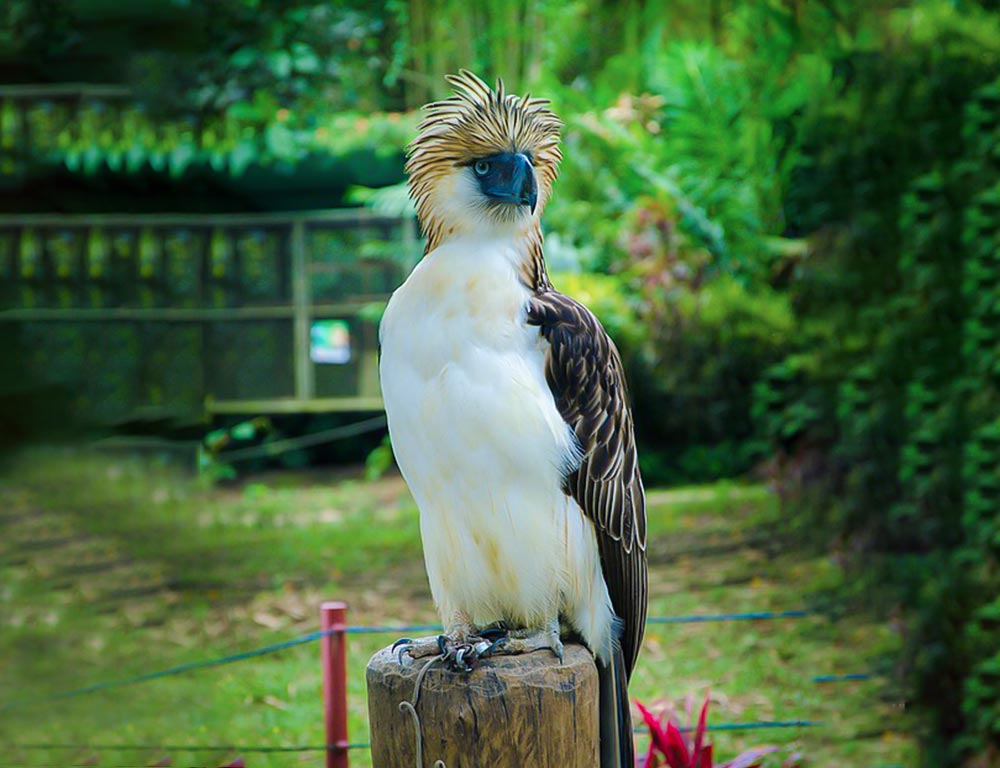
- Scientific name: Pithecophaga jefferyi
- Population: Estimated 400 pairs
- Life span: Up to 40 years in captivity
- Size: 3.3 feet (1 meter)
- Weight: 8 to 18 pounds (4 to 8 kilograms)
- Food: Primarily monkeys, flying lemurs, and other birds
- Status: Critically endangered
The Philippine Eagle, also known as the monkey-eating eagle, inhabits the lush forests of the Philippines.
As an apex predator, it plays a vital role in maintaining the ecological balance. With a wingspan of around 7 feet, it soars through the skies, hunting and nesting in large territories.
Unfortunately, deforestation and habitat loss have led to its critical endangerment. Conservation efforts focus on preserving its habitat and breeding programs to ensure the survival of this majestic bird.
2. Tufted Titmouse
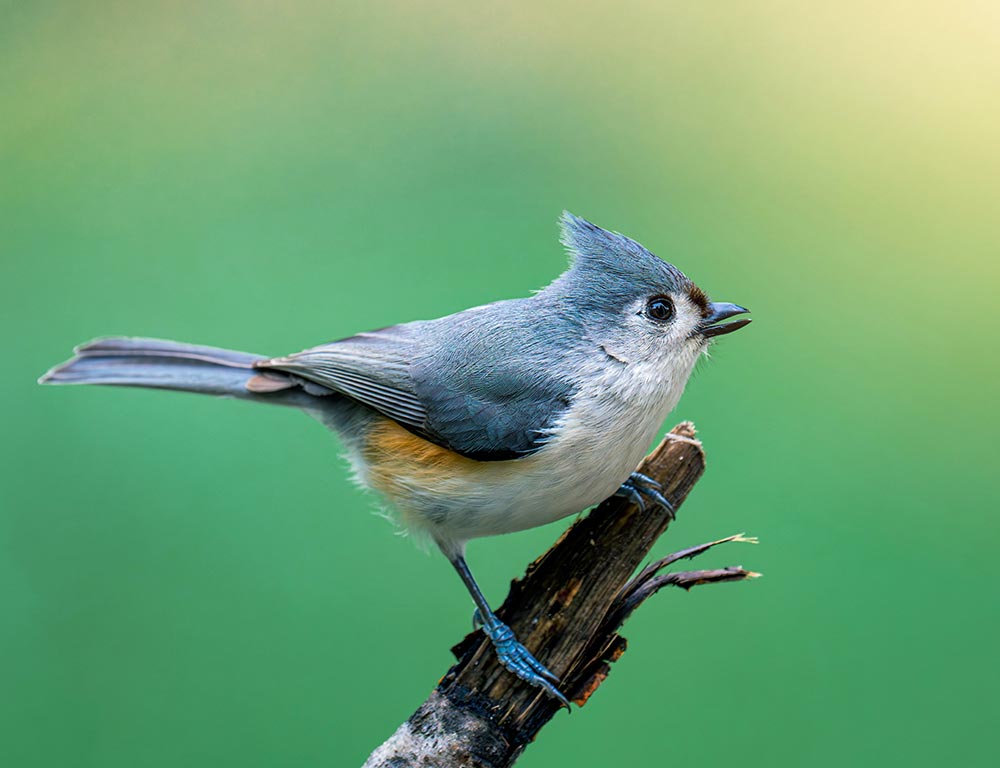
- Scientific name: Baeolophus bicolor
- Population: Abundant and widespread
- Life span: Up to 13 years
- Size: 6 inches (15 cm)
- Weight: 0.7 to 1.2 ounces (20 to 34 grams)
- Food: Insects, seeds, berries
- Status: Least concern
The Tufted Titmouse, found in North America, is a social and acrobatic bird. These small, lively birds move in flocks, foraging for insects and seeds.
Known for their crested appearance, they are resilient and adaptable, thriving in various habitats.
Their melodic calls add charm to woodlands, and they often visit bird feeders, making them a delight for birdwatchers
3. Grey Crowned Crane
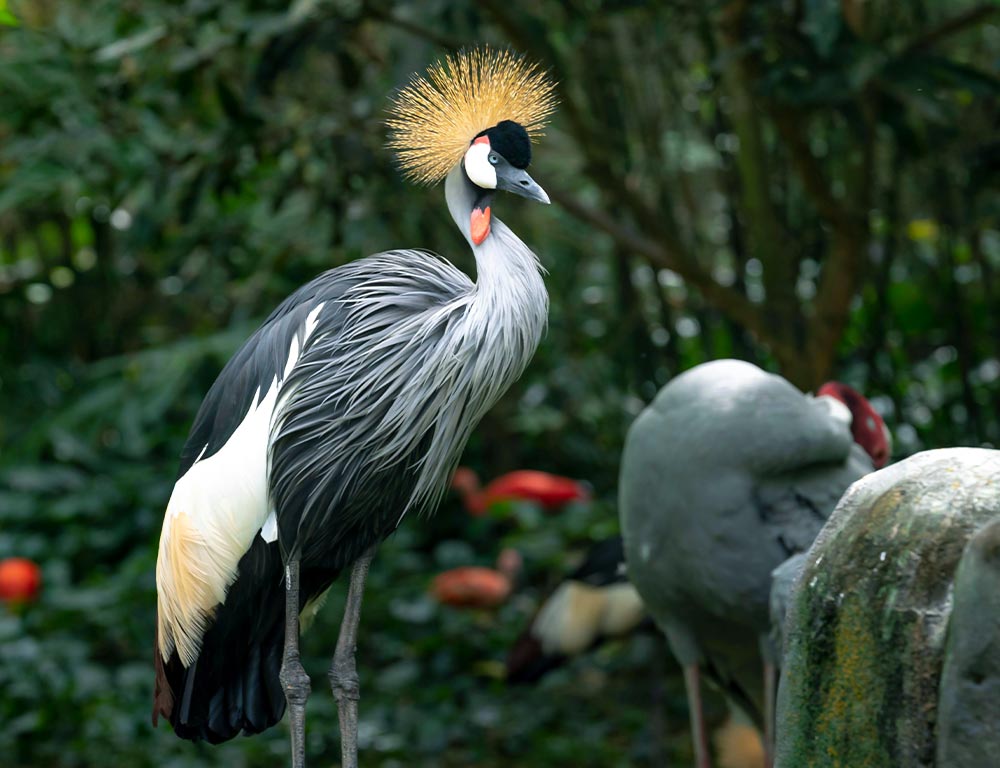
- Scientific name: Balearica regulorum
- Population: Decreasing
- Life span: Up to 25 years
- Size: 3.3 to 3.9 feet (1 to 1.2 meters)
- Weight: 6.6 to 10.1 pounds (3 to 4.6 kilograms)
- Food: Seeds, insects, small vertebrates, and plants
- Status: Endangered
The Grey Crowned Crane, native to Africa, is known for its striking appearance and intricate courtship dances. These elegant birds inhabit wetlands and grasslands, forming monogamous pairs.
Threats like habitat loss and illegal trade contribute to their endangerment. Conservation efforts focus on preserving their habitats and mitigating human-induced threats.
4. Sulphur-Crested Cockatoo
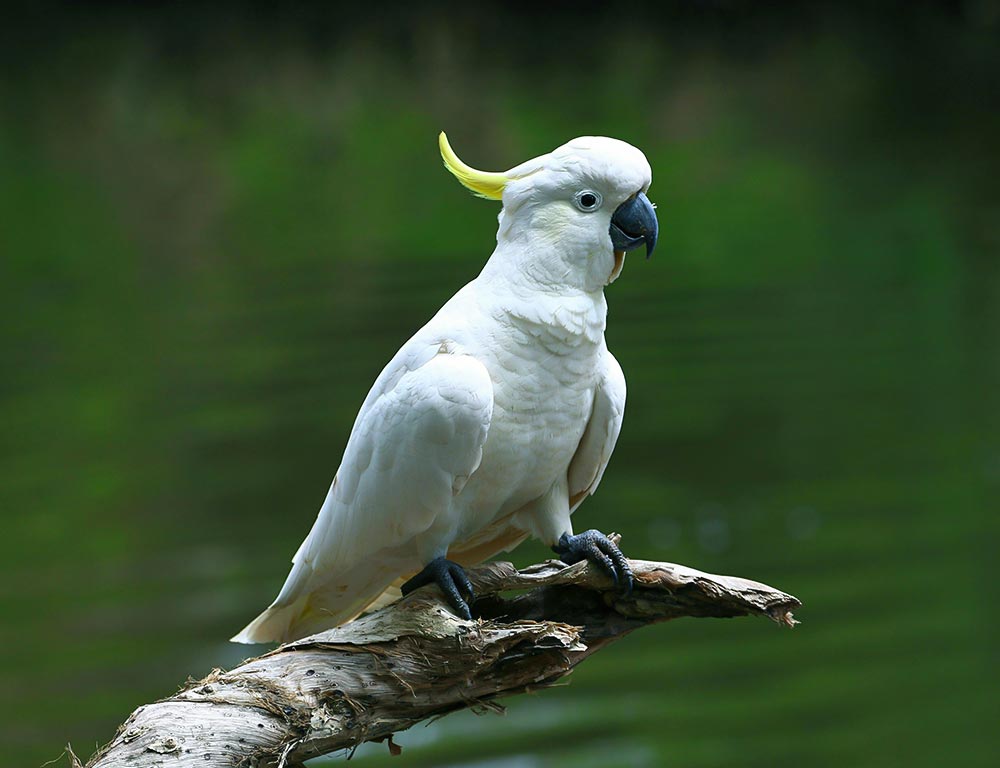
- Scientific name: Cacatua galerita
- Population: Abundant
- Life span: Up to 70 years
- Size: 17 to 20 inches (43 to 50 cm)
- Weight: 1.5 to 2.5 pounds (0.7 to 1.2 kilograms)
- Food: Seeds, nuts, fruits, and insects
- Status: Least concern
The Sulphur-Crested Cockatoo, native to Australia and New Guinea, is a charismatic and social bird. Recognizable by its bright yellow crest, it forms tight-knit flocks and exhibits remarkable intelligence.
Its adaptability to various environments has contributed to its abundance. However, issues like habitat destruction and the pet trade necessitate ongoing conservation efforts.
5. Royal Flycatcher
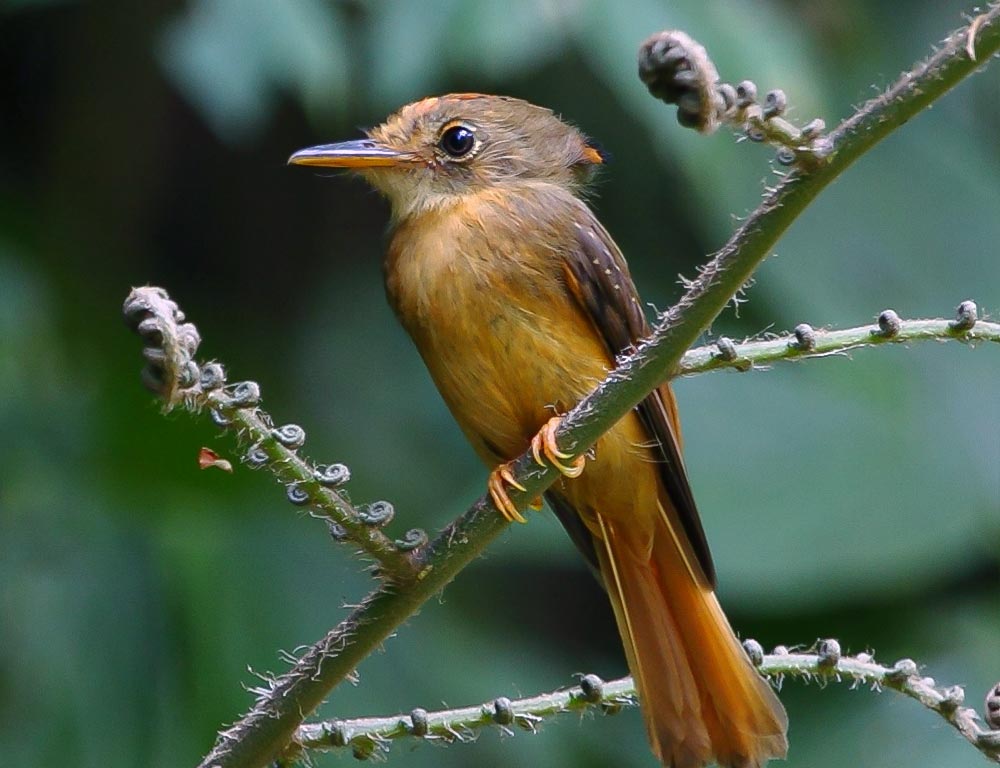
- Scientific name: Onychorhynchus coronatus
- Population: Not well-documented
- Life span: Up to 7 years
- Size: 5.9 to 6.7 inches (15 to 17 cm)
- Weight: Approximately 0.6 ounces (17 grams)
- Food: Insects, spiders, and small vertebrates
- Status: Least concern
The Royal Flycatcher, residing in Central and South America, is renowned for its vibrant plumage and distinctive crest. Preferring dense forests, it utilizes its elaborate crest during courtship displays.
Despite being less studied, their least concern status suggests they are not currently facing significant threats.
Conservation initiatives aim to enhance understanding and protect their habitats from potential future challenges.
6. Dalmatian Pelican
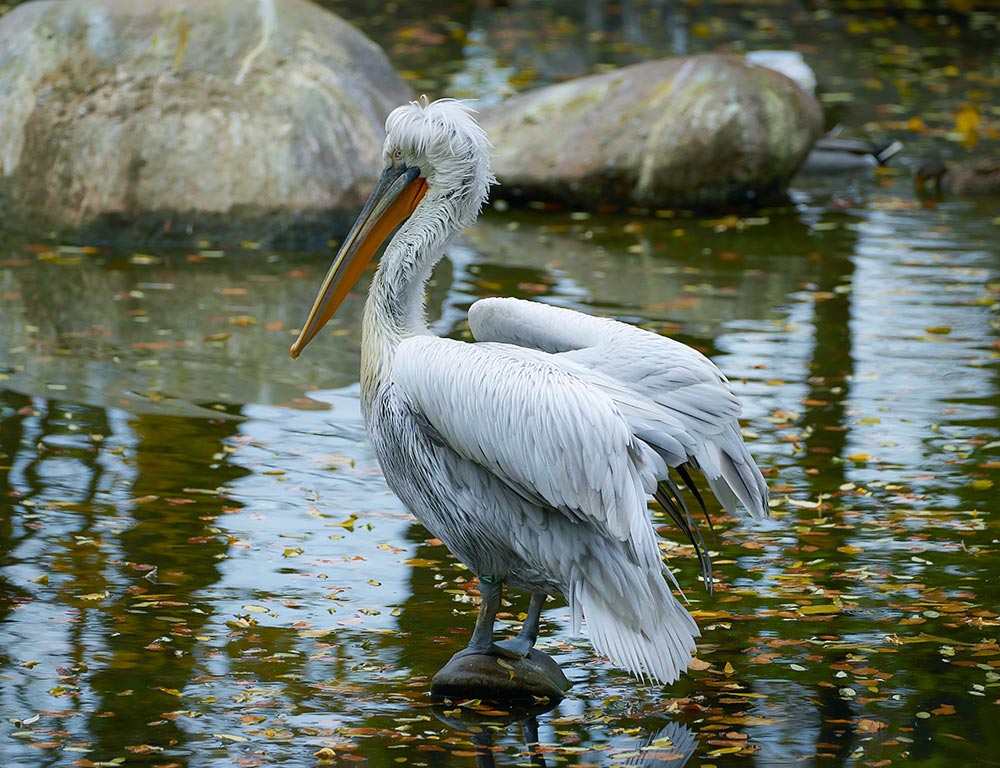
- Scientific name: Pelecanus crispus
- Population: Estimated around 11,000 to 13,000 breeding pairs
- Life span: Up to 20 years
- Size: Approximately 5 feet (1.5 meters) in length
- Weight: 15 to 30 pounds (7 to 14 kilograms)
- Food: Fish, mainly carp, and other aquatic creatures
- Status: Near Threatened
The Dalmatian Pelican, one of the world’s largest freshwater birds, inhabits lakes and rivers in southeastern Europe and Asia.
Recognized by its massive size and distinctively long bill, it is a social bird often found in colonies.
Threats such as habitat loss, disturbance at breeding sites, and pollution contribute to its near-threatened status.
Conservation efforts focus on safeguarding their breeding habitats and mitigating human-induced disturbances.
7. Victoria Crowned Pigeon
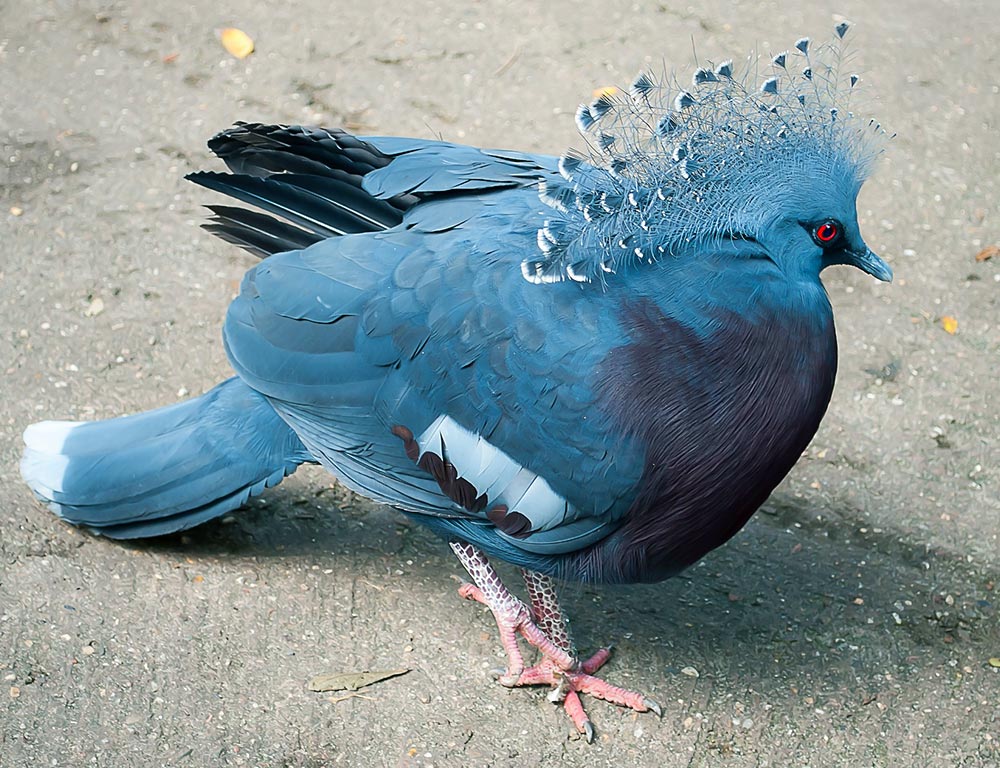
- Scientific name: Goura Victoria
- Population: Unknown
- Life span: Up to 15 years
- Size: 29 inches (74 cm) in length
- Weight: Approximately 4.4 to 7.7 pounds (2 to 3.5 kilograms)
- Food: Seeds, fruits, and insects
- Status: Near Threatened
Endemic to Papua New Guinea, the Victoria Crowned Pigeon is known for its regal appearance, adorned with elegant blue and white plumage.
Dwelling in lowland forests, it forages on the forest floor for seeds, fruits, and insects. Although their population status is not well-documented, habitat loss and hunting pose significant threats.
Conservation initiatives aim to assess their populations, protect their habitats, and raise awareness about the importance of their conservation.
8. Golden Pheasant
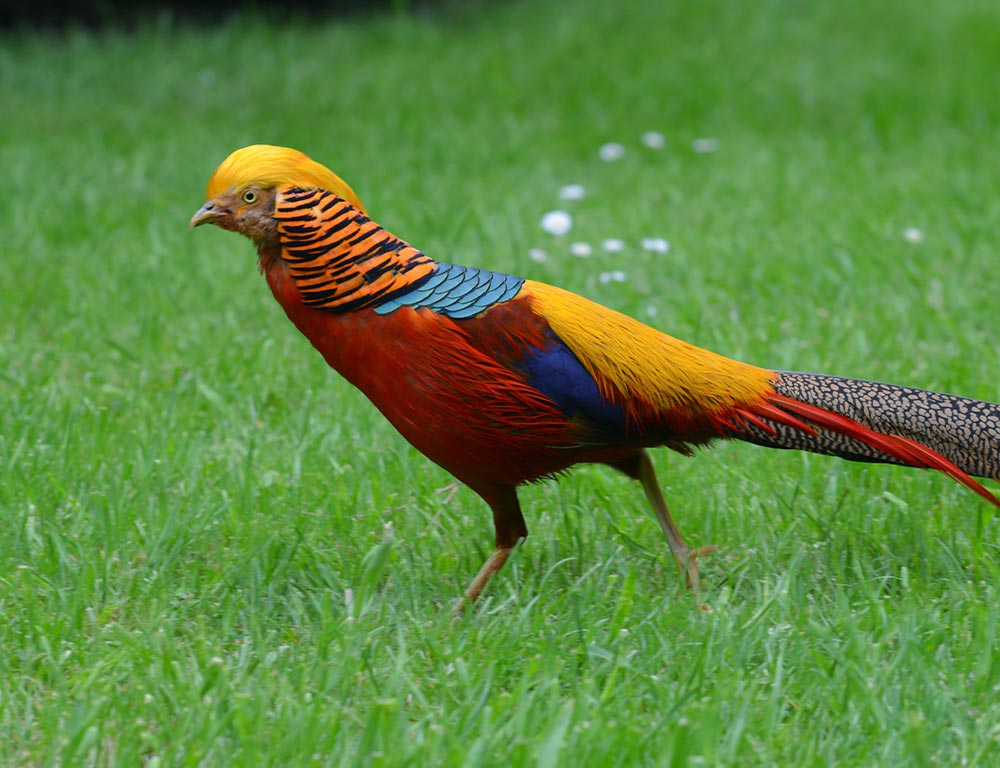
- Scientific name: Chrysolophus pictus
- Population: Abundant in captivity; wild populations decreasing
- Life span: Up to 15 years
- Size: 35 to 41 inches (90 to 105 cm) in length
- Weight: 2.2 to 3.3 pounds (1 to 1.5 kilograms)
- Food: Seeds, berries, insects, and plants
- Status: Least Concern
Native to western China, the Golden Pheasant is renowned for its vibrant and ornate plumage.
In the wild, it inhabits dense forests and mountainous areas. While its captive populations are abundant, wild populations face habitat loss and hunting threats.
Conservation efforts focus on preserving their natural habitats and mitigating the impact of human activities on their populations.
9. Palm Cockatoo
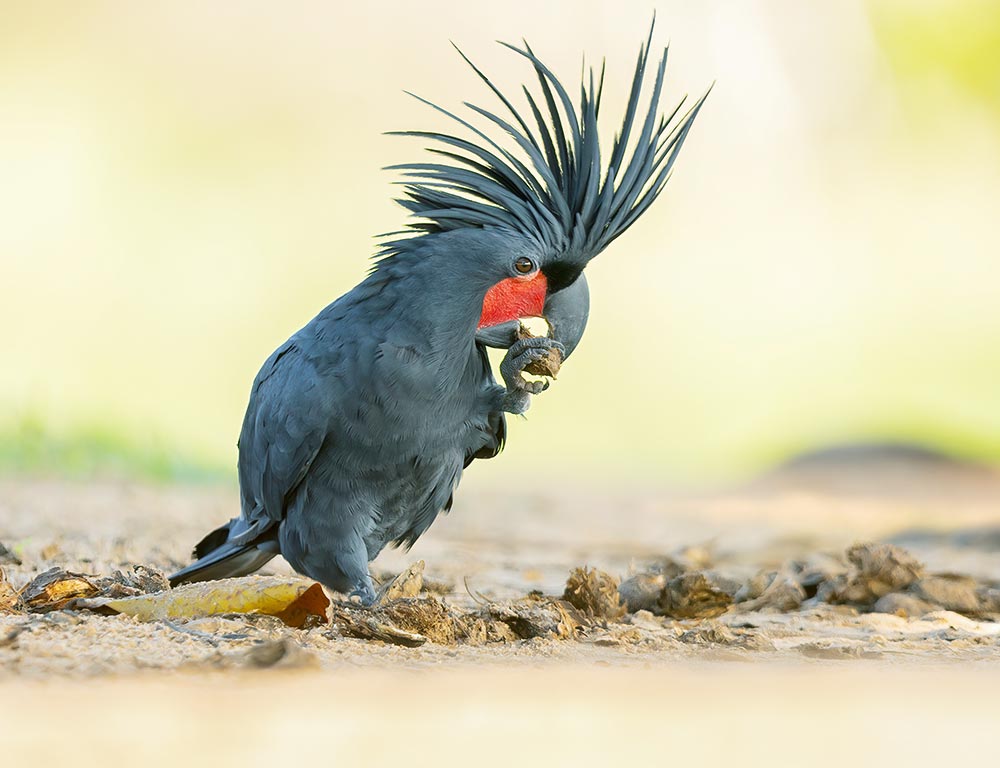
- Scientific name: Probosciger aterrimus
- Population: Unknown
- Life span: Up to 60 years
- Size: 21 inches (55 cm) in length
- Weight: 2.6 to 3.3 pounds (1.2 to 1.5 kilograms)
- Food: Nuts, seeds, fruits, and insects
- Status: Least Concern
Endemic to Australia, the Palm Cockatoo is recognized for its distinctive appearance, including a large black crest and a unique bill shape.
Inhabiting rainforests and woodlands, these birds are known for their vocalizations and complex courtship rituals.
While their least concern status indicates a stable population, ongoing conservation efforts aim to address potential threats, including habitat degradation and illegal trade.
10. White-Crested Hornbill
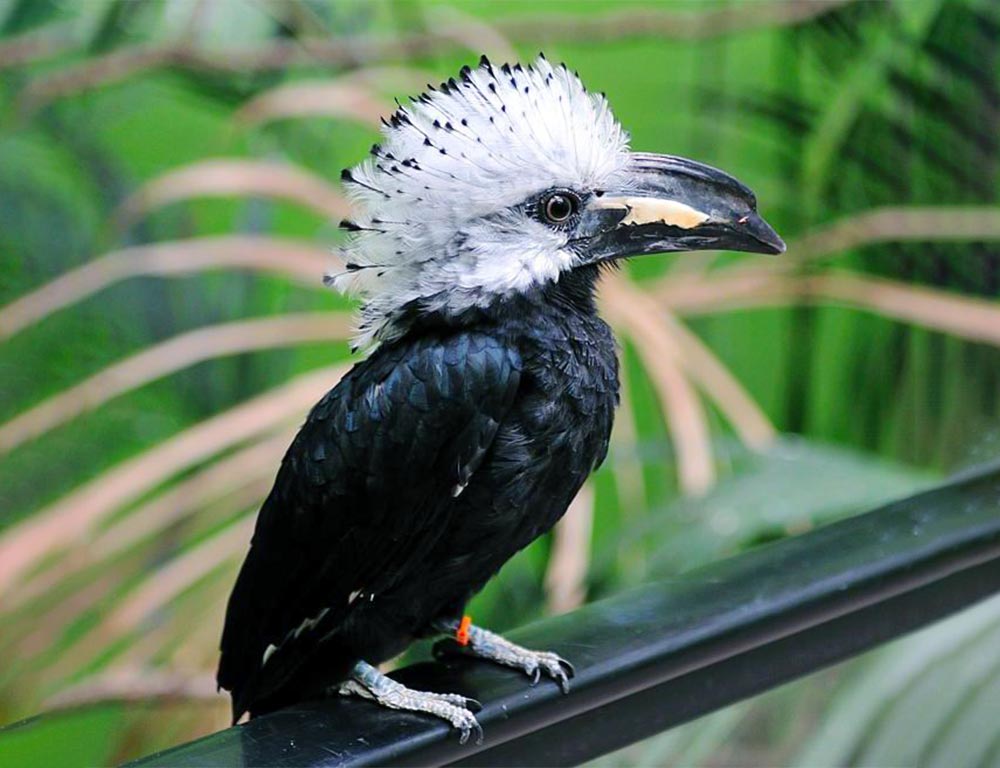
- Scientific name: Aceros comatus
- Population: Not well-documented
- Life span: Around 25 years
- Size: 28 inches (71 cm) in length
- Weight: Approximately 3.5 to 4.4 pounds (1.6 to 2 kilograms)
- Food: Fruits, insects, small animals
- Status: Least Concern
The White-Crested Hornbill is native to Southeast Asia, inhabiting the tropical forests of Indonesia and Malaysia.
Identified by their striking appearance, including a large white crest and black plumage, these hornbills are primarily frugivorous.
They are crucial in seed dispersal, contributing to the forest ecosystem’s health.
While currently labeled as the least concern, ongoing conservation efforts focus on preserving their habitats and addressing potential threats, such as habitat loss and hunting.
11. Amazonian Royal Flycatcher
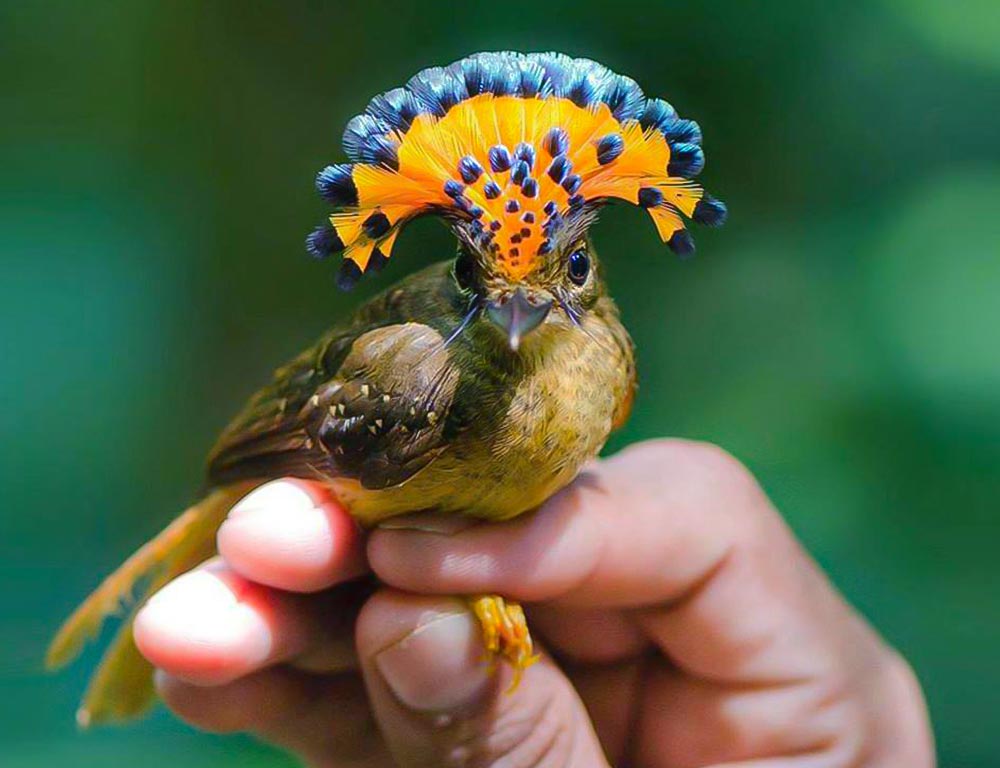
- Scientific name: Onychorhynchus coronatus
- Population: Not well-documented
- Life span: Up to 7 years
- Size: 6.7 inches (17 cm)
- Weight: Approximately 0.6 ounces (17 grams)
- Food: Insects, spiders, and small vertebrates
- Status: Least Concern
Inhabiting the Amazon rainforest, the Amazonian Royal Flycatcher is distinguished by its vibrant plumage and ornate crest.
It prefers dense forests, so it feeds on insects and small vertebrates. While not extensively studied, their least concern status indicates a relatively stable population.
Conservation efforts aim to increase knowledge about their ecology and protect the Amazon rainforest, where they play a vital role in the ecosystem.
12. Great Curassow
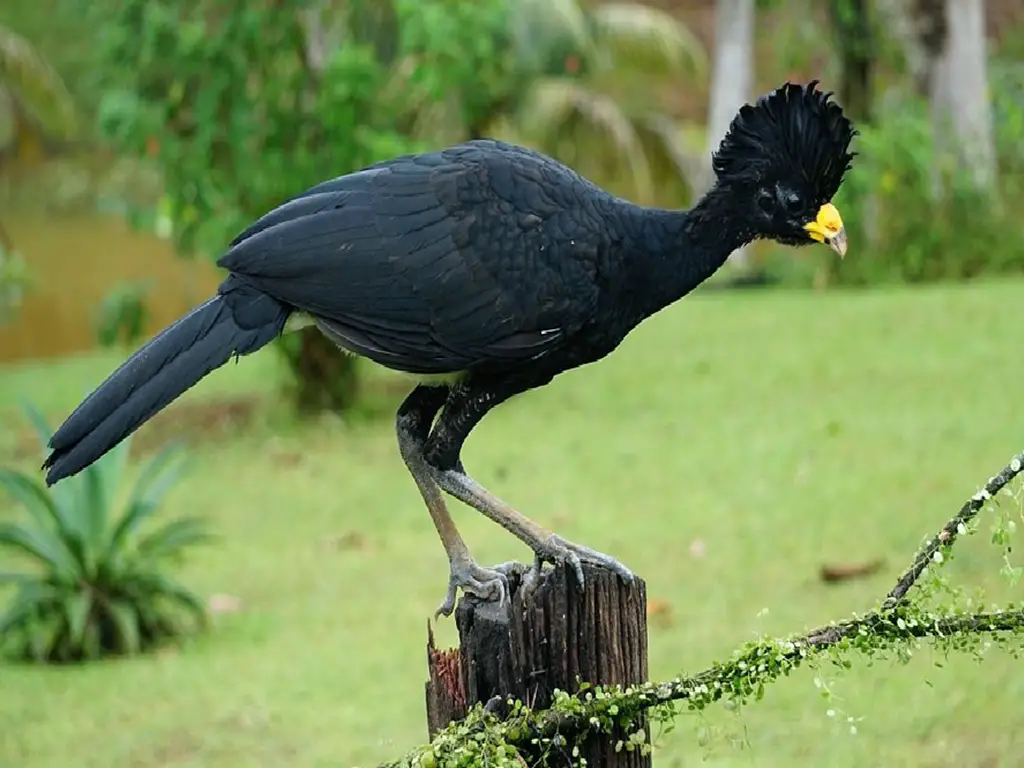
- Scientific name: Crax rubra
- Population: Decreasing
- Life span: Up to 20 years
- Size: 39 to 41 inches (99 to 104 cm) in length
- Weight: 12 to 15 pounds (5.4 to 6.8 kilograms)
- Food: Fruits, seeds, insects, and small animals
- Status: Near Threatened
The Great Curassow is a large bird found in the rainforests of Central and South America. Recognizable by its striking black coloration and prominent crest, it plays a crucial role in seed dispersal.
Despite being near threatened due to habitat loss and hunting, conservation initiatives aim to protect their habitats and raise awareness about the importance of preserving these magnificent birds.
13. Temminck’s Tragopan
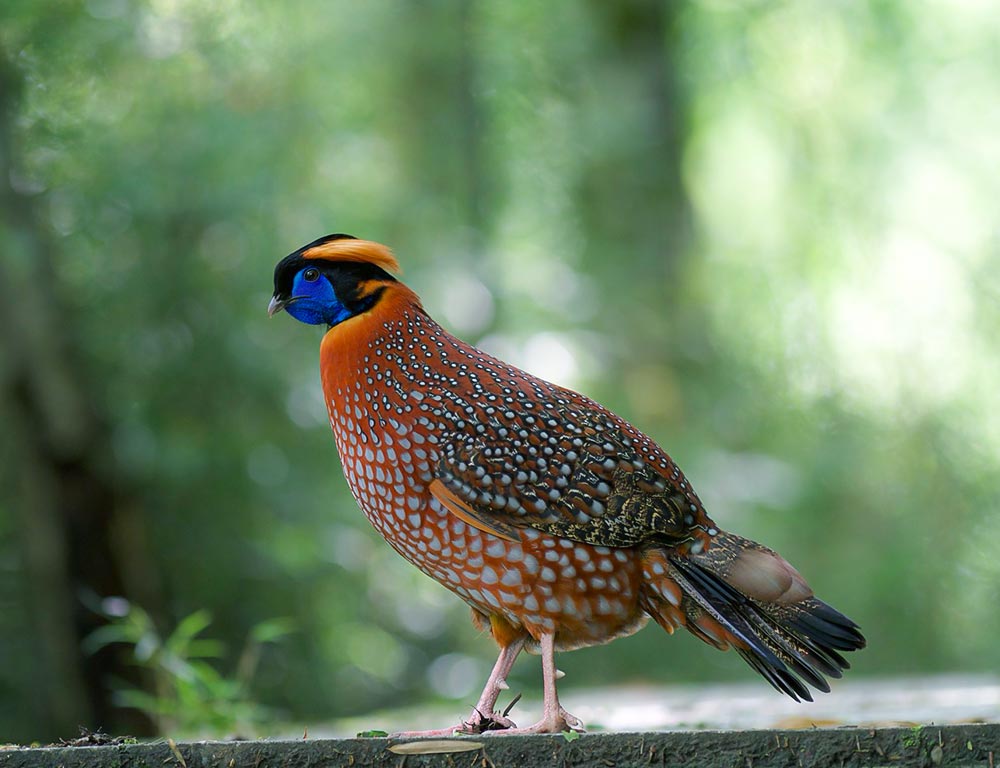
- Scientific name: Tragopan temminckii
- Population: Decreasing
- Life span: Up to 10 years
- Size: 25 inches (64 cm) in length
- Weight: 2.2 to 3.3 pounds (1 to 1.5 kilograms)
- Food: Fruits, seeds, insects, and plants
- Status: Vulnerable
Endemic to the eastern Himalayas, Temminck’s Tragopan is known for its vibrant plumage and unique courtship displays.
Inhabiting dense forests, it feeds on various plant materials and insects. Habitat loss and hunting contribute to its vulnerable status.
Conservation efforts focus on protecting its habitats, addressing hunting pressures, and engaging local communities in conserving this remarkable pheasant species.
14. Smew
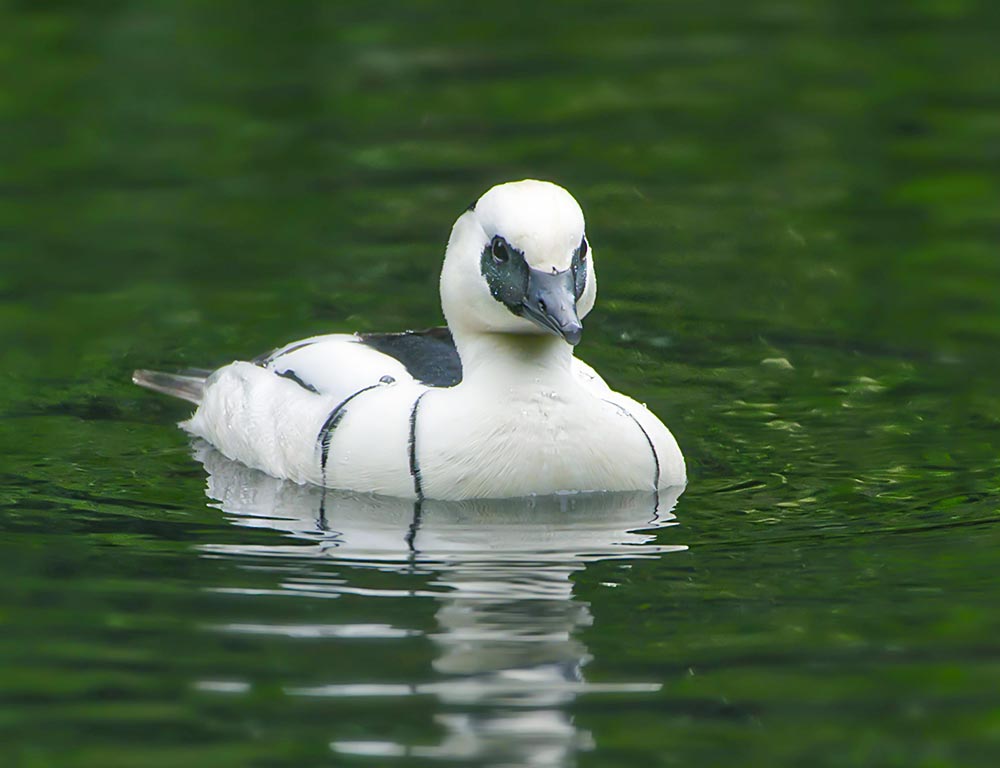
- Scientific name: Mergellus albellus
- Population: Stable, with some fluctuations
- Life span: Around 8 years
- Size: 15 inches (38 cm)
- Weight: Approximately 1.1 pounds (500 grams)
- Food: Small fish, insects, and crustaceans
- Status: Least Concern
The Smew is a striking diving duck found in freshwater lakes and rivers in northern Europe and Asia.
With its black and white plumage and distinctive “panda face,” the Smew is well-adapted to its aquatic environment.
Although their populations face some fluctuations, conservation efforts concentrate on preserving their habitats, especially during the breeding season, and ensuring water quality in their range.
15. Crested Duck
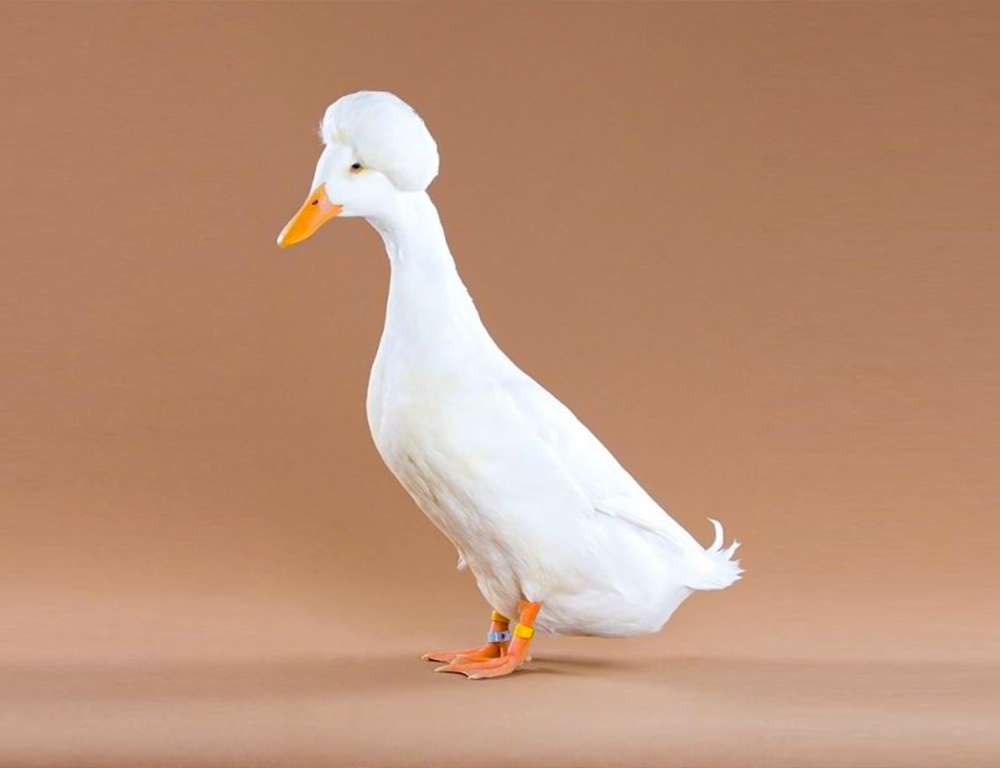
- Scientific name: Lophonetta specularioides
- Population: Stable
- Life span: Up to 10 years
- Size: 18 to 20 inches (46 to 51 cm)
- Weight: 2.2 to 3.3 pounds (1 to 1.5 kilograms)
- Food: Aquatic plants, small invertebrates
- Status: Least Concern
The Crested Duck is native to South America and inhabits various wetland habitats.
Recognized by its distinctive crest, these ducks are adaptable and can be found in fresh and saltwater environments. Their least concern status reflects a generally stable population.
Conservation efforts focus on preserving their diverse habitats and addressing potential threats such as habitat degradation and pollution.
16. Northern Cardinal
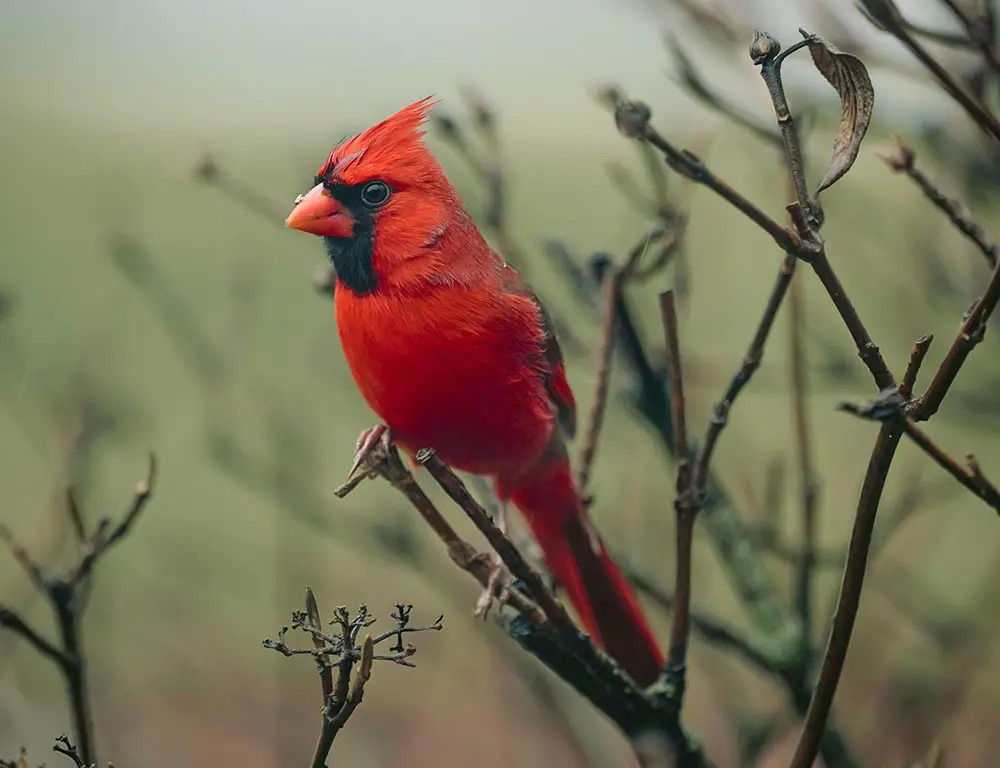
- Scientific name: Cardinalis cardinalis
- Population: Abundant
- Life span: Up to 15 years
- Size: 8 to 9 inches (20 to 23 cm)
- Weight: Approximately 1.5 ounces (42 grams)
- Food: Seeds, fruits, and insects
- Status: Least Concern
The Northern Cardinal, native to North America, is a beloved and easily recognizable bird known for its vibrant red plumage.
Thriving in a variety of habitats, including gardens and woodlands, they are skilled seed and fruit eaters. Their adaptability and stable population contribute to their least concern status.
Conservation efforts often involve providing suitable habitats and raising awareness about the importance of maintaining biodiversity in urban and suburban environments.
17. Pileated Woodpecker
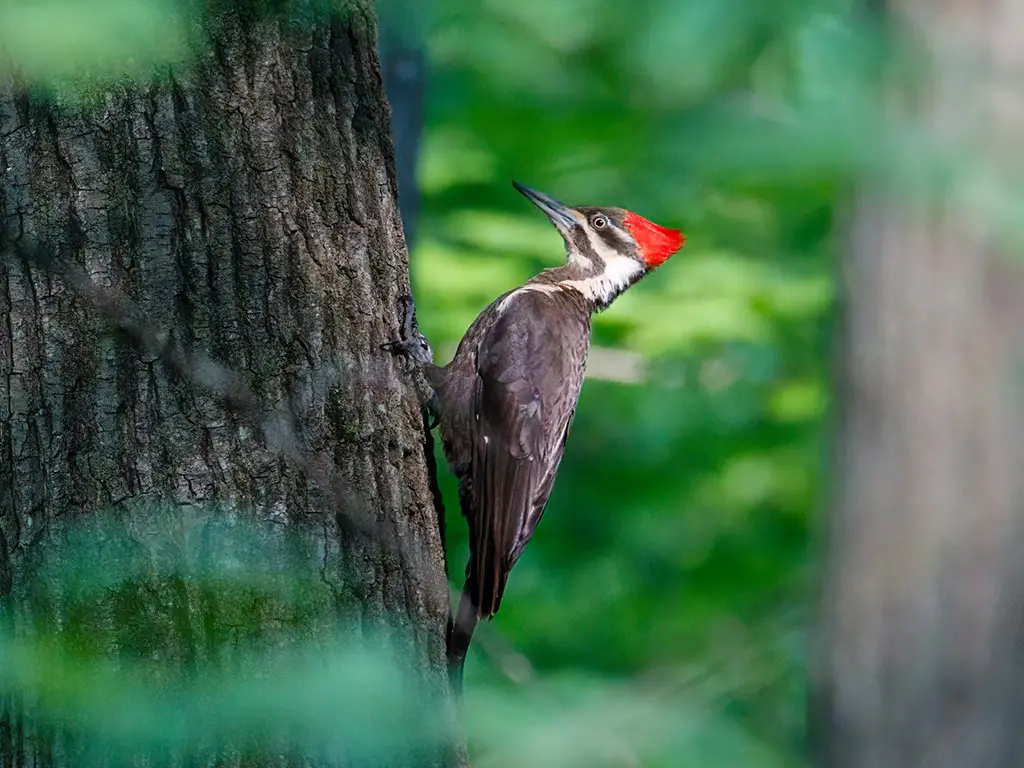
- Scientific name: Dryocopus pileatus
- Population: Stable
- Life span: Up to 12 years
- Size: 16 to 19 inches (41 to 48 cm)
- Weight: 8 to 12 ounces (230 to 340 grams)
- Food: Insects, especially wood-boring larvae
- Status: Least Concern
The Pileated Woodpecker, with its distinctive red crest and loud drumming, is the largest woodpecker in North America.
Inhabiting mature forests, they are crucial in controlling insect populations by foraging for wood-boring larvae.
Their least concern status reflects a stable population, and conservation efforts focus on preserving old-growth forests, which are essential for their nesting and foraging habits.
18. Red-crested Cardinal

- Scientific name: Paroaria coronata
- Population: Stable
- Life span: Up to 5 years
- Size: 7.5 inches (19 cm)
- Weight: Approximately 1.5 ounces (43 grams)
- Food: Seeds, fruits, and insects
- Status: Least Concern
The Red-crested Cardinal, native to South America, is known for its striking appearance with a vibrant red crest atop its head.
Found in open habitats like grasslands and savannas, they are adaptable and often spotted near human settlements.
Their least concern status indicates a stable population, and conservation efforts focus on protecting their habitats from potential threats like habitat loss and urbanization.
19. Andean Cock-of-the-rock
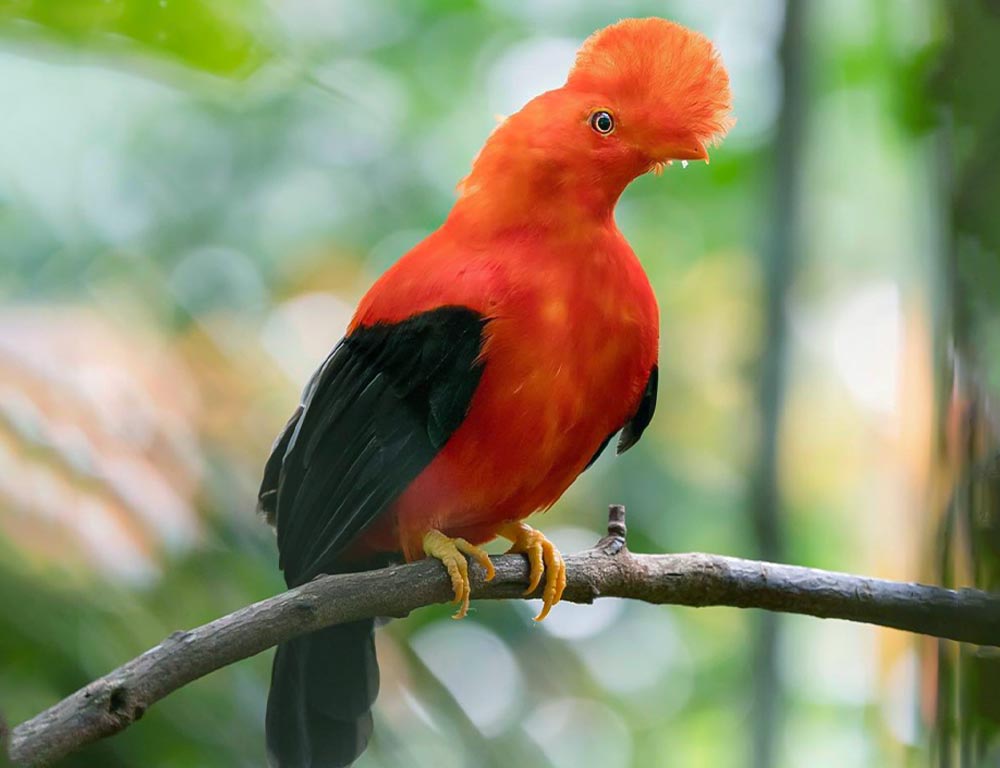
- Scientific name: Rupicola peruvianus
- Population: Stable
- Life span: Up to 15 years
- Size: 12 to 13 inches (30 to 33 cm)
- Weight: Approximately 9.5 to 13.5 ounces (270 to 380 grams)
- Food: Fruits, insects, small vertebrates
- Status: Least Concern
The Andean Cock-of-the-rock, with its vibrant orange plumage and distinctive crest, is native to the cloud forests of South America.
Forming leks during the breeding season, males engage in elaborate displays to attract females. Despite their striking appearance, their populations are stable.
Conservation efforts focus on preserving their cloud forest habitats and addressing potential threats like deforestation and habitat fragmentation.
20. Helmeted Curassow
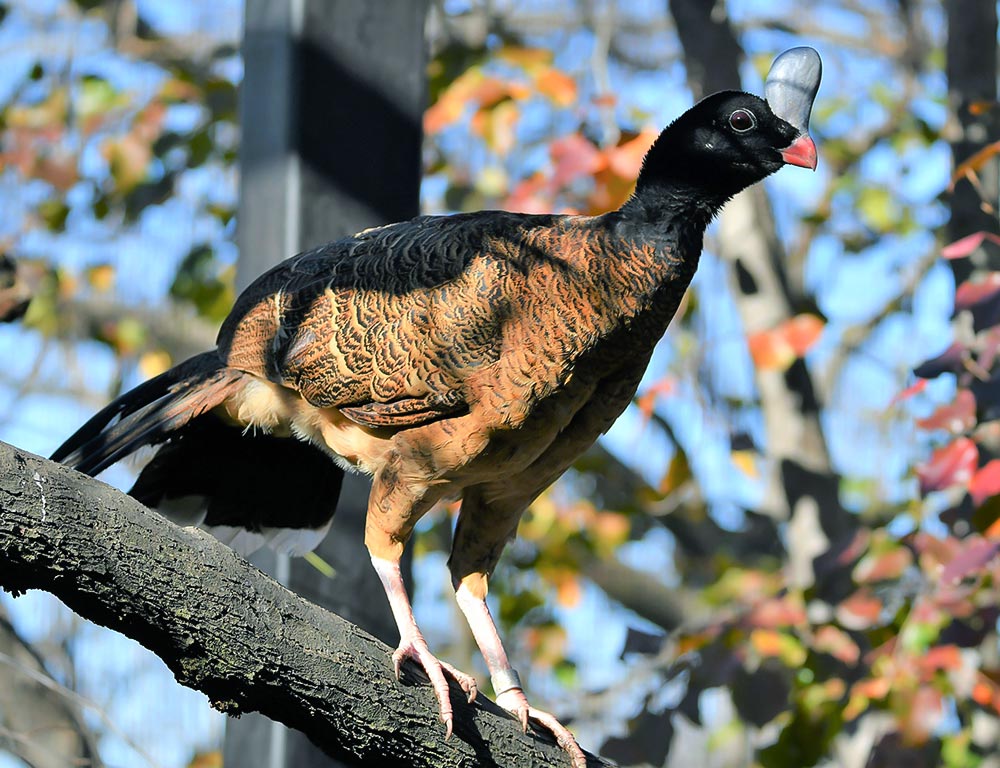
- Scientific name: Pauxi pauxi
- Population: Decreasing
- Life span: Up to 15 years
- Size: 32 to 40 inches (81 to 102 cm)
- Weight: 7 to 11 pounds (3.2 to 5 kg)
- Food: Fruits, seeds, and insects
- Status: Vulnerable
The Helmeted Curassow, native to the Andean forests of South America, is characterized by its distinct helmet-like casque.
This large bird faces habitat loss and hunting threats, contributing to its vulnerable status.
Conservation efforts are crucial for protecting their habitats, regulating hunting activities, and raising awareness about the importance of preserving this unique and charismatic species.
21. Crested Partridge
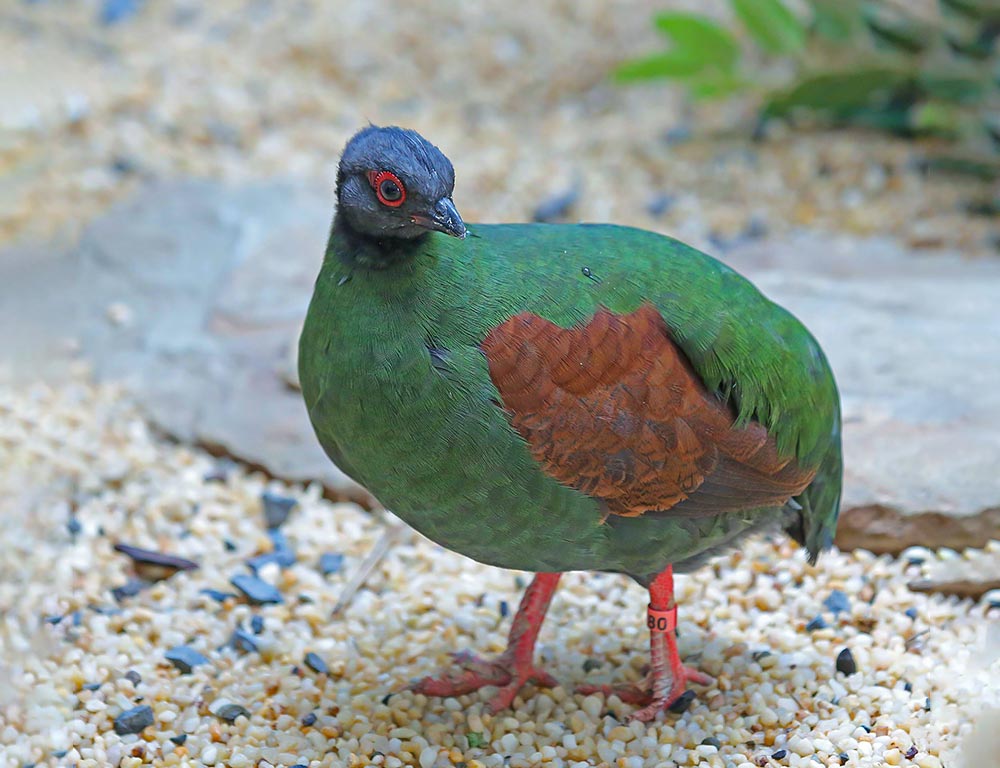
- Scientific name: Rollulus rouloul
- Population: Unknown
- Life span: Up to 5 years
- Size: 10 inches (25 cm)
- Weight: Approximately 9.5 to 13 ounces (270 to 370 grams)
- Food: Seeds, fruits, insects
- Status: Least Concern
The Crested Partridge, native to Southeast Asia, is a ground-dwelling bird with a distinctive crest. Inhabiting dense forests, they forage for seeds, fruits, and insects.
While their specific population is not well-documented, their least concern status suggests they are not currently facing significant threats.
Conservation efforts often involve preserving their diverse forest habitats and maintaining ecological balance in these ecosystems.
22. Eurasian Hoopoe
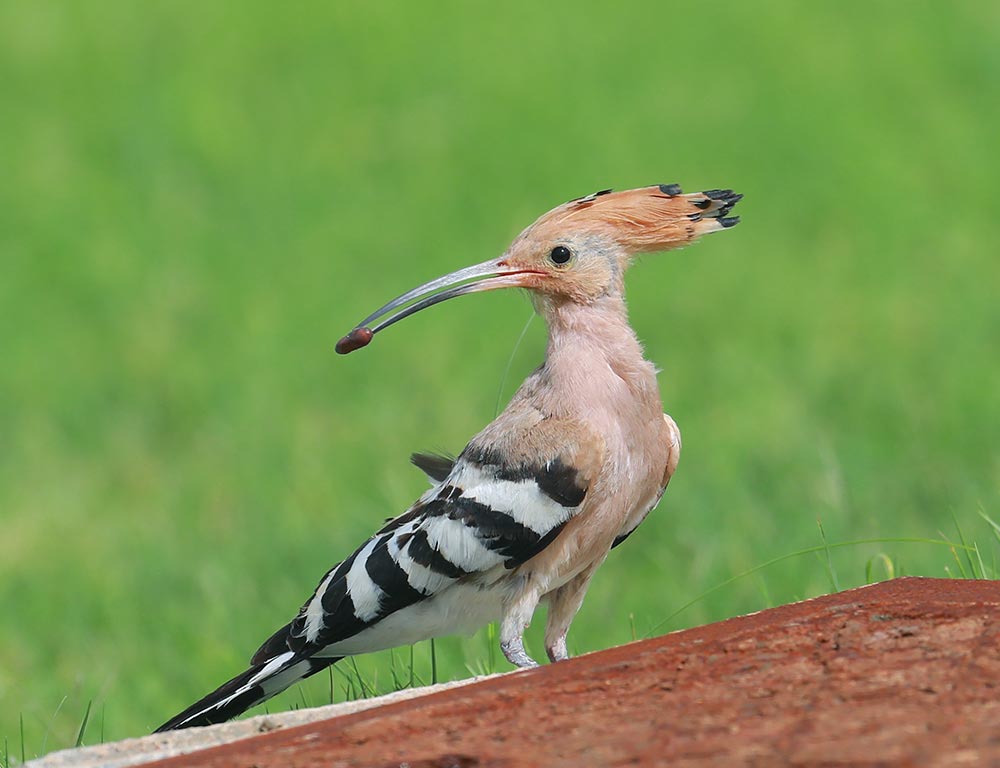
- Scientific name: Upupa epops
- Population: Stable
- Life span: Up to 10 years
- Size: Approximately 11 inches (28 cm)
- Weight: Around 2.8 ounces (80 grams)
- Food: Insects, larvae, and small invertebrates
- Status: Least Concern
The Eurasian Hoopoe is a distinctive bird with a unique crown of feathers. Found across Europe, Asia, and North Africa, it inhabits various environments.
Known for its distinctive “hoo-hoo” call and ability to catch insects with its long, slender bill, the Eurasian Hoopoe is well-adapted to open landscapes and wooded areas.
Its least concern status indicates a stable population, and conservation efforts focus on maintaining suitable habitats and raising awareness about the importance of these fascinating birds in ecosystems.
23. Wood Duck
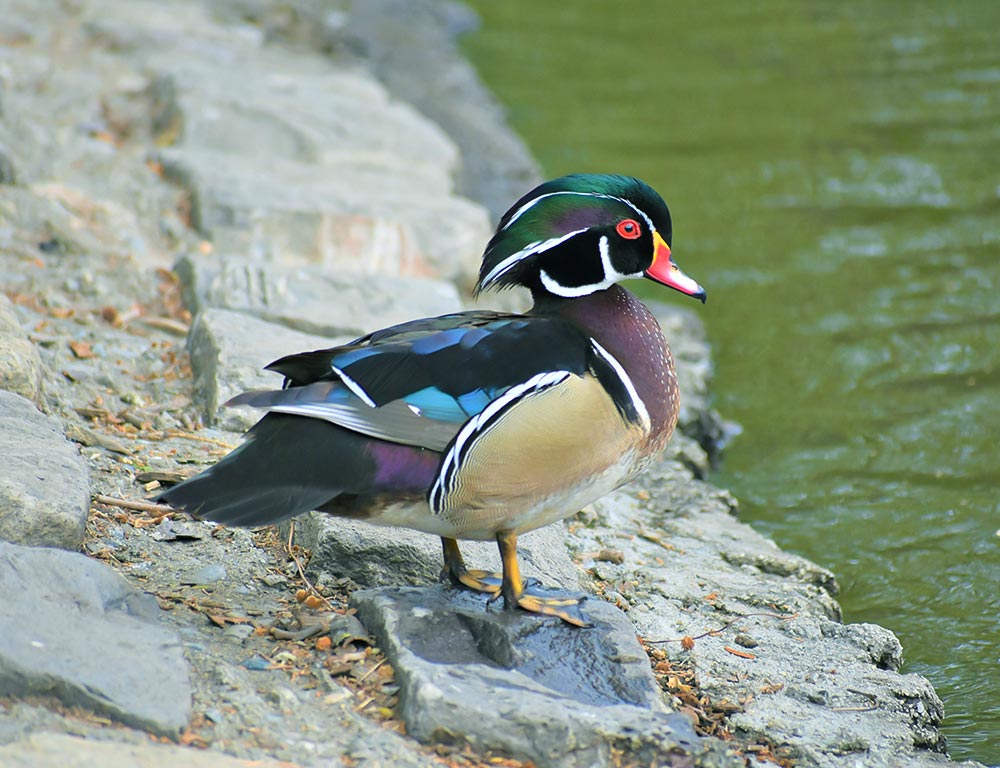
- Scientific name: Aix sponsa
- Population: Stable
- Life span: Up to 15 years
- Size: 19 to 21 inches (48 to 53 cm)
- Weight: 1 to 2 pounds (0.45 to 0.9 kilograms)
- Food: Aquatic plants, insects, seeds
- Status: Least Concern
The Wood Duck, native to North America, is known for its vibrant plumage and distinctive markings. Inhabiting wooded swamps, lakes, and ponds, they are skilled at perching in trees.
These ducks are cavity nesters, often using abandoned woodpecker holes for nesting.
Their populations are generally stable, and conservation efforts focus on preserving suitable habitats, providing nest boxes, and managing wetland ecosystems.
Wrapping Up
These stunning birds with mohawks showcase the marvels of nature’s creativity and resilience.
From the vibrant Eurasian Hoopoe to the charismatic Sulphur-crested Cockatoo and the colorful Wood Duck, each species contributes to the intricate tapestry of our ecosystems.
Their adaptability, unique behaviors, and striking appearances underscore the importance of conservation efforts to safeguard their habitats.
As we marvel at their beauty, let us also embrace our role as stewards of the environment, ensuring the continued existence of these remarkable creatures for future generations to appreciate and cherish. Thank you very much.